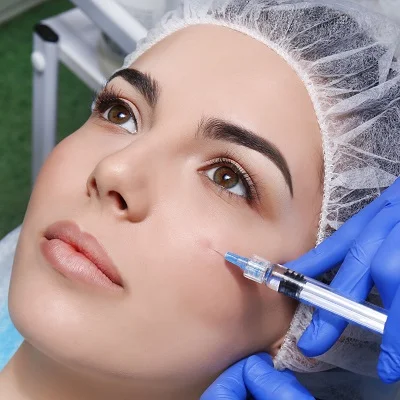Cheek fillers are a widely used non-surgical solution for enhancing facial contours, restoring midface volume, and achieving a youthful appearance. Many individuals considering this treatment ask, are there any side effects of cheek fillers? While cheek fillers are generally safe, understanding potential reactions, how to manage them, and ways to minimize risk is crucial for anyone seeking this aesthetic enhancement.
What Is Cheek Filler Treatment And How It Works?
Cheek Fillers Injections in Dubai(حقن حشو الخد في دبي) involves the injection of dermal fillers, typically hyaluronic acid-based, into the midface area to restore volume and improve contours. These fillers work by:
- Restoring lost volume: Filling hollows in the cheeks caused by aging or weight changes.
- Providing lift and definition: Enhancing cheekbones and overall facial symmetry.
- Stimulating collagen production: Supporting firmer and healthier skin over time.
- Hydrating the skin: Hyaluronic acid attracts water, resulting in plumper, smoother skin.
- While the procedure is minimally invasive, understanding possible side effects ensures that patients are well-prepared for treatment and recovery.
Importance Of Awareness About Side Effects:
Knowing the side effects of cheek fillers is important for safe and satisfying results:
- Mild and temporary reactions: Swelling, redness, tenderness, or itching at the injection site.
- Bruising: Small blood vessels can be affected, leading to minor discoloration.
- Lumps or uneven texture: Sometimes occur but can usually be corrected.
- Asymmetry: Rare if injections are precisely administered.
- Awareness of these effects helps manage expectations and encourages following aftercare protocols to minimize complications.
Types Of Cheek Fillers And Side Effects:
Different types of cheek fillers may present varying side effect profiles:
- Hyaluronic acid fillers: Generally well-tolerated; minor swelling or bruising is common.
- Calcium hydroxylapatite fillers: Firmer texture may cause temporary pressure or mild discomfort.
- Poly-L-lactic acid fillers: Gradual volume restoration may result in slight swelling or tenderness over multiple sessions.
- Combination treatments: Using fillers with skin boosters can slightly increase the number of injection points but remains safe with minimal side effects.
- Understanding the specific filler used helps patients anticipate recovery experiences and potential reactions.
Preparation And Aftercare:
Proper preparation and aftercare are essential to reduce the likelihood and severity of side effects. Before treatment:
- Avoid blood-thinning medications or supplements to minimize bruising.
- Cleanse the face thoroughly and remove makeup.
- Discuss medical history, allergies, and previous reactions with the practitioner.
- After treatment:
- Apply cold compresses to reduce swelling and discomfort.
- Avoid strenuous activity, heat exposure, or touching the treated area for several days.
- Follow recommended skincare routines to support healing and maintain hydration.
- Monitor for prolonged or severe reactions and seek advice if necessary.
- Adhering to these steps ensures smoother recovery and optimal results.
Ideal Candidate For Cheek Fillers:
The ideal candidate for cheek filler treatment is someone seeking volume restoration and contour enhancement with a realistic understanding of potential side effects. Candidates should:
- Be in good general health and free from conditions that may complicate healing.
- Have realistic expectations about treatment outcomes and mild reactions.
- Be committed to proper aftercare to reduce swelling, bruising, and discomfort.
- Prefer non-surgical, minimally invasive options for facial rejuvenation.
- Evaluating these factors ensures safe and effective treatment with minimal complications.
How To Choose The Right Clinic?
Selecting a professional clinic is critical to minimize side effects from cheek fillers:
- Ensure the practitioner is experienced in midface volumization and facial anatomy.
- Confirm availability of appropriate filler types and pain management options.
- Verify clear communication about the procedure, potential reactions, and aftercare.
- Check patient reviews or testimonials for evidence of safe, natural-looking results.
- A qualified clinic ensures both safety and precision, reducing the risk of side effects while achieving desired outcomes.
Risks And Benefits:
Cheek Fillers Injections(حقن حشو الخد) are generally safe, with mostly mild, temporary side effects. Benefits include:
- Restored midface volume and improved facial contours.
- Immediate visible enhancement with minimal downtime.
- Non-surgical, minimally invasive option for youthful rejuvenation.
- Stimulated collagen production for firmer, healthier skin over time.
- Understanding the balance of risks and benefits allows individuals to make informed treatment decisions.
Common FAQs About Cheek Filler Side Effects:
What are the most common side effects?
Temporary swelling, redness, tenderness, minor bruising, or small bumps.
Can serious side effects occur?
Serious complications are rare but may include infection or vascular issues; prompt attention is necessary.
How long do side effects last?
Most mild reactions resolve within a few days to a week.
Can side effects be corrected?
Hyaluronic acid fillers can be dissolved if lumps or asymmetry occur.
Does following aftercare reduce side effects?
Yes, proper post-treatment care minimizes swelling, bruising, and discomfort.
Conclusion:
Understanding are there any side effects of cheek fillers highlights that while minor and temporary reactions are possible, proper preparation, skilled administration, and adherence to aftercare guidelines ensure a safe procedure. Cheek fillers can provide natural, balanced midface volume restoration and enhanced contours with minimal risk, making them a reliable choice for aesthetic enhancement.

